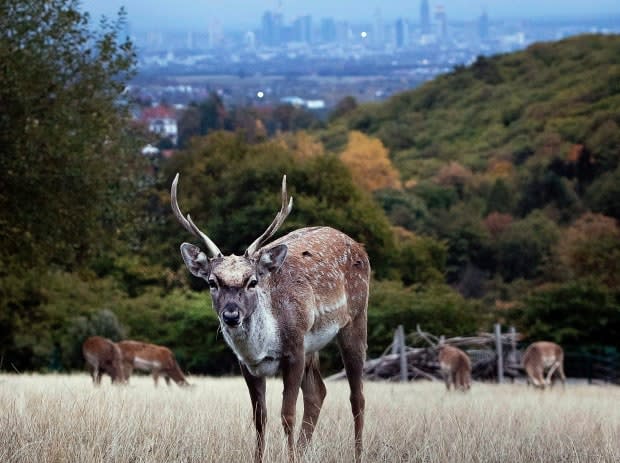Plan moves ahead to wipe out non-native deer population on B.C. island

The days of fallow deer running amok on Sidney Island could be numbered.
The non-native species was introduced to the Southern Gulf Islands in the early 1900s by European pioneers and since then, the pale brown spotted deer have multiplied by the hundreds on Sidney Island.
The animals have devastated native plant populations and wreaked havoc on the local ecosystem during their decades on the island, which is located off the southwest coast of British Columbia and is around nine square kilometres in size.
Now local First Nations, the federal government, and an association representing the island's approximately 50 residents have a plan to get rid of every last deer.
"If you're going to deal with it, you have to completely eradicate them from the island," said Eric Pelkey, hereditary chief of the Tsawout First Nation and representative of the W̱SÁNEĆ Leadership Council.
Island invaders
Pelkey said the bracken fern, which once grew abundantly on the island and was used by local Indigenous people as both a food source and to clean fish, has been completely wiped out by the deer, as have many other native plants.
"It's kind of hard on our people when we are used to getting some of our medicines out there and they are just not there anymore," he said, speaking on CBC's All Points West on Monday.
Pelkey also said the fallow deer have driven away the local black-tailed deer that used to populate the island and were hunted there traditionally by Indigenous people.
According to Coastal Conservation, an organization that encourages the restoration of island ecosystems through invasive species removal, removing fallow deer from Sidney Island could also increase songbird and raptor breeding and improve conditions for insects, frogs and snakes.
And the restoration process could begin soon.
Dogs and choppers
Parks Canada controls almost half of the island as part of the Gulf Islands National Park Reserve. According to Pelkey, the federal government will soon be putting out contracts for the job of rounding up and ridding the island of the deer.
Pelkey said the plan is to have dogs herd the deer into large net pens and then have trained marksmen shoot to kill. He said helicopters could also be employed with marksmen in them to catch any strays the dogs miss.
Eliminating all of the deer, said Pelkey, is key to the plan's success.
"If we just leave a few, then they will establish themselves again," he said, adding that moving them would just create the same problem somewhere else.
Pelkey said some Tsawout elders had initial concerns about the culling because it is counter to their cultural ways of hunting to wipe out an entire population. Once it was explained the animals are invasive, Pelkey said these elders agreed to support the effort to get rid of them.
"We expect that there will be people that are against this but that's where we're prepared to explain ourselves," he added.
The B.C. SPCA, which has spoken out against culls before, hasn't taken an official stance on the project yet. Chief Scientific Officer Sara Dubois said they are waiting to review the final project proposal.
"The deer on Sidney Island now are being hunted by local First Nations and property owners, with several hundred removed each year," Dubois said in an email to CBC.
"Over the past decade, this has been thousands of deer hunted. And this will continue if an eradication program is not implemented, so a professional eradication program would actually reduce total deaths."
'Multiply like rabbits'
This will not be the first attempt to control the fallow deer population on Sidney Island, though it is the most thorough plan to date.
A limited entry hunt was initiated in 1996 and continued until 2001 in an effort to reduce numbers. According to Parks Canada, a total of 11,287 deer have been removed from Sidney Island through a series of management actions between 1981 and 2010.
But the problem, says Pelkey, is that "they multiply like rabbits."
The next step in the plan is to secure professionals for the job and set a start date.
According to Pelkey, all the fallow deer meat will be distributed among W̱SÁNEĆ people.
W̱SÁNEĆ Leadership Council Society is a unified, legal governing body comprised of three W̱SÁNEĆ First Nations: Tsartlip, Tseycum, and Tsawout.
LISTEN | Pelkey on the plan to eradicate fallow deer on Sidney Island:

 Yahoo Finance
Yahoo Finance 